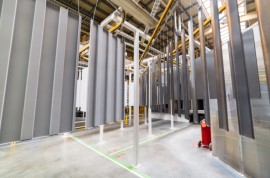In the context of increasingly evident climate change and increasingly severe pressure from environmental pollution, reducing emissions has become one of the top priorities for countries around the globe. Vietnam, as one of the rapidly growing economies in Southeast Asia, is also trying to integrate into this race.

With the extremely serious efforts of the Vietnamese Government to achieve the emission reduction goals, it can be said that the pressure on domestic businesses is not light, especially manufacturing enterprises. So, facing the current trend of reducing emissions in the world and in Vietnam, what challenges are manufacturing enterprises facing to adapt to this trend while ensuring sustainable development for themselves and society?
The trend of reducing emissions in the world
For decades, many countries around the world have pursued a "Brown Economy", which is an economy based on fossil energy sources, ignoring social problems, environmental degradation, and the depletion of natural resources. This viewpoint has caused significant damage to the environment, increasing greenhouse gas emissions such as CO2, SO2, CH4, etc., and climate change on a global scale.
Since the 2008 financial crisis, facing the urgent need to solve not only economic challenges but also environmental problems, the concept of "Green Economy" has begun to be widely used and has become an inevitable trend in many countries around the world. According to the United Nations Environment Programme (UNEP), "Green Economy" can be understood as an economy with low carbon emissions and efficient and socially inclusive resource use.
The Paris Agreement on Climate Change has set a goal of limiting global warming to less than 2 degrees Celsius compared to pre-industrial levels and is determined to make efforts to limit the increase to 1.5 degrees Celsius, to avoid the worst impacts of climate change. With the participation of more than 190 countries around the world, the Paris Agreement represents a global vision of the need for cooperation in protecting the environment and maintaining sustainable development. According to the United Nations, to achieve the goal set by the Paris Agreement, global emissions need to be reduced by 45% by 2030 and achieve net-zero (the total amount of greenhouse gas emissions emitted is equal to or less than the amount of emissions absorbed or removed from the environment) by 2050.
Many countries around the world are making efforts to reduce emissions and respond to climate change. For example, the European Union has set a goal of reducing greenhouse gas emissions by at least 55% by 2030 and moving towards becoming a climate-neutral region by 2050. In addition, the EU is also the first trading region in the world to impose a carbon tax on imported goods (EU-CBAM Mechanism). The US has set a goal of reducing greenhouse gases by at least 50~52% compared to 2005 levels by 2030 and aiming for a net-zero economy by 2050. Besides, China has achieved the target of reducing greenhouse gases per unit of GDP by 60~65% compared to 2005 levels by 2030.
These goals and efforts are just a part of what is going on in the world. Each country is implementing different measures and policies to reduce emissions and contribute to global goals on climate change.
Emission reduction trend in Vietnam
Government policies
In Vietnam, the Government is also making serious efforts to promote the process of reducing emissions, aiming to build a green economy.
Decision 896/QĐ-TTg on the National Strategy on Climate Change for the period up to 2050 clearly stated Vietnam's position that "Adapting to climate change and implementing the net emissions target by “ 0" is an opportunity for sustainable development, the highest priority in development policies, the highest ethical standards of all levels, industries, businesses, and people." The approval of this strategy has demonstrated Vietnam's commitment to reducing greenhouse gas emissions and responding to climate change. Accordingly, the goal of reducing greenhouse gas emissions for each period has been set as follows: By 2030, ensuring that total national greenhouse gas emissions decrease by 43.5% compared to the business-as-usual (BAU) scenario; Emissions peak in 2035, then decline rapidly; By 2050, ensure that total national greenhouse gas emissions reach net zero emissions.
*The business-as-usual (BAU) scenario is a scientifically based assumption about the level of greenhouse gas emissions under normal socio-economic development conditions in the future when no greenhouse gas emission mitigation measures have been implemented.
Decision 896/QĐ-TTg also sets the task of inventorying greenhouse gas emissions for businesses as follows: From 2022 on, implement greenhouse gas inventory and reduce greenhouse gas emissions for businesses. Annual emissions of 3,000 tons of CO(2)eq or more; From 2030, conduct a greenhouse gas inventory and reduce greenhouse gas emissions for establishments that annually emit 2,000 tons of CO(2)eq or more; 500 tons of CO(2)eq or more from 2040; and 200 tons of CO(2)eq or more from 2050.
Also in 2022, the Government issued Decree 06/2022/NĐ-CP detailing the reduction of greenhouse gas emissions, protecting the ozone layer, and developing the carbon market. This decree demonstrates Vietnam's concern for climate change and identifies specific directions to minimize negative impacts. Regarding the development of the carbon market, Decree 06 stipulates the roadmap as follows:
1. The period of up to the end of 2027
a) Develop regulations on carbon credit management, activities of exchanging greenhouse gas emission quotas and carbon credits; develop operating regulations for the carbon credit exchange;
b) Pilot implementation of the carbon credit exchange and offset mechanism in potential fields and guide the implementation of the domestic and international carbon credit exchange and offset mechanism in accordance with laws and the international treaties to which the Socialist Republic of Vietnam is a member;
c) Establish and organize the pilot operation of a carbon credit trading floor from 2025;
d) Implement activities in order to improve capacity and raise awareness about carbon market development.
2. The period from 2028
a) Organize and operate an official carbon credit exchange in 2028;
b) Regulate activities connecting and exchanging domestic carbon credits with regional and world carbon markets.
Current state of businesses
Currently, the majority of supporting industry enterprises in Vietnam are small and medium-sized enterprises with a total annual revenue of no more than 200 billion VND. Most businesses still use old machinery and technology, which are out of date by more than 30 years compared to developed countries, consume a lot of energy, and have poor waste treatment, causing environmental pollution. Many factories and enterprises have not invested in waste treatment systems and use fossil fuels as fuel in production. This process has created gases: CO2, CO, NO, SO2, etc., causing serious air pollution and even the greenhouse effect. Even FDI enterprises have green development models, but the rate of high technology is still very low. According to a report by Vietnam's Association of Foreign Investment Enterprises (VAFIE), only 5% of FDI enterprises use high technology, 15% of enterprises use medium technology, and 80% of FDI enterprises use outdated technology.
A report from the General Statistics Office shows that currently, over 30% of the country's supporting industry enterprises are still using manually controlled equipment; over 50% of enterprises are using semi-automatic equipment; the remaining 10% of enterprises use automation equipment; and less than 10% of enterprises use robots in production lines. In fact, only a few businesses using high-tech production lines are truly aware of and offer effective energy use solutions.
Challenges for Vietnamese businesses
Emission reduction is increasingly becoming a strong trend worldwide and in Vietnam, with increasingly clear impacts on businesses. In the survey "Demand for Green Transformation in Industry," with the participation of 134 manufacturing enterprises, conducted by International Logistics Joint Stock Company (InterLOG) and Vietnam Industry Support Alliance (VISA), partly reflected businesses' views on the impacts of emissions reduction trends and Net-zero policies on businesses. Businesses have made important comments, emphasizing the risk of reduced competition in the market due to pressure to comply with strict standards. They also noted the risk of reduced export orders when international partners require compliance with greenhouse gas emission reduction standards. In addition, reduced attractiveness to investors and increased costs due to carbon emission taxes and fees are also considered significant challenges for businesses.
These show that businesses need to quickly adapt and implement measures to reduce greenhouse gas emissions to protect not only the environment but also their sustainability in the international market. However, as seen from the survey "Demand for Green Transformation in Industry", the difficulties and barriers that businesses often encounter in the process of achieving the Net-zero goal and implementing green transformation are very noteworthy. These difficulties include the legal system still being vague and lacking specific guidance, along with the costs arising from measuring, inventorying, changing production processes, and transformating technology.
(*) Click here for detailed survey results
Toward a green future
When facing the challenges of climate change and environmental protection, understanding and accurately measuring emission sources is very important. According to Mr. Truong Vinh Khang, Head of Sustainable Development Department, British Standards Institute (BSI), whether emission reduction measures are feasible and effective depends greatly on correctly identifying emission sources in businesses. Accordingly, businesses need to clarify factors such as what sources of emissions there are, whether the business can control them or not, how much they emit, and how much they contribute to the total emissions of the business and of each product.

For many years, the environment has been severely damaged, and human efforts to protect the environment still seem very small. Today, reducing greenhouse gas emissions is an urgent global need, requiring the participation of the entire society, including businesses. For small and medium-sized enterprises, this is probably not easy; it requires a methodical and synchronous research and investment process, from changing people's thinking to investing in modern machinery and equipment.
However, success in reducing emissions not only ensures environmental sustainability but also opens up a series of attractive new business opportunities. Businesses themselves will enjoy many important benefits, including optimizing production processes, improving energy use efficiency, and saving costs related to energy, raw materials, and environmental management. This not only helps increase the competitiveness of businesses but also promotes the improvement of business strategy, reshaping the direction of businesses to actively participate in the green transformation process towards a sustainable and prosperous future.




















